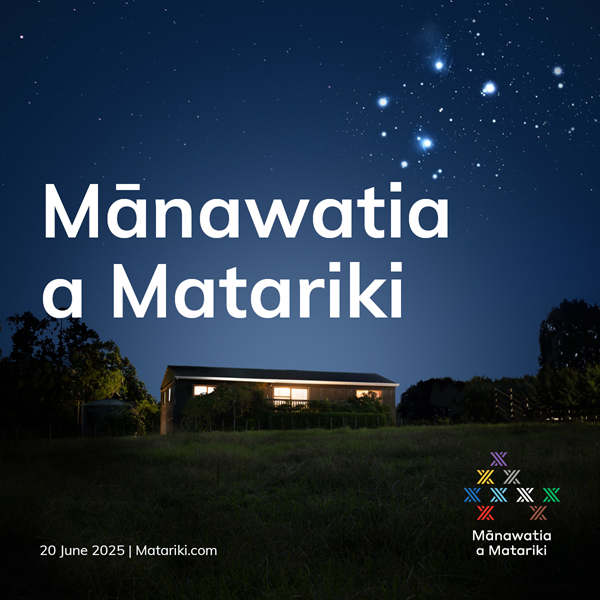Matariki: A new year, a new way
By Melisa Chase on June 19, 2025 in Cultural capability
Melisa reflects on what Matariki means and how to get involved - a time to reset, reconnect, honour the past and shape the future.
Each year, the Gregorian calendar quietly dictates the rhythm of our lives — a system brought to Aotearoa and overlaid upon our own Māori traditions. Matariki offers something else. Something grounded. Rooted in the whenua, shaped by the stars, and steeped in our historical context. Matariki invites us to reframe time through an indigenous lens — relocating our reset to the rise of winter stars, not the ticking of the Gregorian clock.
It is a call to remember, reflect, and renew — anchored in both the celestial and the terrestrial. The stars Tupuānuku, Tupuārangi, Waitī, Waitā, Waipuna-ā-rangi, and Ururangi connect us to the whenua and waters. Matariki, Hiwa-i-te-Rangi, and Pohutukawa tie us to health and wellbeing, our aspirations, and those we have lost. Together, they form a triangulation — us, the stars, and the taiao — a reminder that we are part of something greater; everything is connected.

This year, the national narrative widens to include Puanga (or Puaka in Te Waipounamu), a tohu already well-established in the western regions of Aotearoa. For many schools and communities, Puanga is nothing new. They’ve long recognised that Māori are not a monolith — our practices shift with landscape, dialect, and iwi, making Puanga unique to these areas. Tamariki in these spaces are already unlearning the colonial idea of “one-size-fits-all” and instead saying, “Here, we follow Puanga.”
As Chey Wilson said, “The differences are nuanced instead of poles apart.” While Puanga offers a reading of the westerly weather systems for western iwi, and Matariki brings messages from the rising of a distinct star cluster, the intent remains the same: to observe, celebrate, and mark Te Matahi o te Tau — the Māori New Year. So rather than getting caught up in the differences, especially if they don’t apply to your region, focus on the values that sit at the heart of this time. As Dr Rangi Matamua says, it’s about “honouring the past, celebrating who we are, and looking forward to a bright and prosperous future.”
If you're wondering how to honour Matariki this year — start local. Reach out to a school, daycare centre, kura kaupapa Māori or kōhanga reo near you to see how you can get involved. If one isn’t marking the day, another will be. Many have created beautiful, tamariki-led traditions grounded in local knowledge and mātauranga Māori. They’ll remind you that transformation is already happening — one tamaiti, one kura, one kōrero at a time.
Resist the urge to over commercialise it — shifting from marketing to meaning and consumption to connection. Matariki isn’t about pressure or performance; it’s not a second New Year’s Eve. It’s a soft landing. A gentle reset. If you’re not in redbands, sneakers, sweats, and rocking bed hair, you might be missing the point. Keep it simple. Join your local marae or hapori | community celebration. My local marae, Ngāti Whātua Ōrākei, hosts a magnificent Matariki hautapu that draws in diverse crowds before dawn breaks - a gathering steeped in tradition, mātauranga transmission, and the reclamation of tikanga. However you choose to mark the day, do it with intention - breathe, reflect, reset, and reboot.
In a political climate that has made life uncertain for many, Matariki is an easy and powerful segue to change. This is the rise of Hawaiki Hou — a new beginning that draws on the wisdom of the past to shape a future grounded in Te Tiriti o Waitangi. A future where true biculturalism stands side by side.
Image credit: matariki.com
If this kōrero resonates with you and you’re wondering what next - reach out.
Contact Melisa to explore how we can support your school, kura, or organisation to honour Matariki and embed mātauranga Māori in meaningful ways.
Other articles you might like
In this blog, Laura shares insights into how the Niho Taniwha framework can guide educators to create learning environments where ākonga Māori can be Māori.
A personal reflection on the last 40 years, the progress made and how we can build upon that.
"As educators, we need to comprehensively understand Te Tiriti, the history and its ongoing impacts; and to continue to strive for what we know is important: for excellence and equity for ākonga Māori and all learners."
